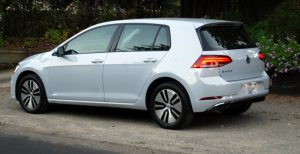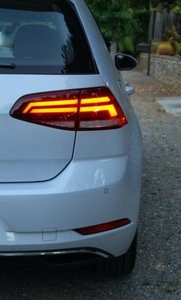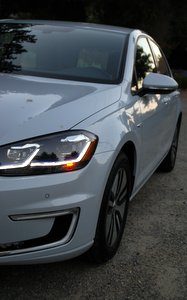More Range Plus the VW Experience
In the wake of the diesel emissions scandal, VW is emphasizing its electric car goals, but so far, its only all-electric car is the e-Golf. I enjoyed a week with a handsome White Silver example. The Volkswagen Golf is a car buff magazine perennial favorite, especially the GTI model, because it’s compact, but not too small, extremely practical, drives with enthusiasm and handles precisely. In addition, the interior feels like a driver’s car and not simply a motoring appliance.

The beauty of the 2017 Volkswagen e-Golf is that it doesn’t lose any of its Golf virtues in the transition to an EV. Its 700-pound battery lives along the bottom of the car, giving it a low center of gravity without intruding a bit into the passenger or cargo room. At 3,455 pounds, the e-Golf weighs only 432 pounds more than a four-door Golf automatic, thanks to some careful engineering and use of high-strength steel.
No Sound, New Sounds
With the sound and vibration of an engine removed, tire noise, wind and EV functions come to the fore, so the engineers worked to make the e-Golf extremely quiet inside. They also installed a tone that’s emitted at low speeds to warn pedestrians that the silent cruiser is coming.

The e-Golf can accommodate four folks inside comfortably, and haul 22.8 cubic feet of gear with the rear seat up. Flip it down to make that 52.7 cubic feet.
The original e-Golf’s 85-kW electric motor generates 115 horsepower, but the new one’s motor is boosted to 100 kW, and develops 134 horsepower. The new motor churns out a generous 214 pounds-feet of torque versus 199 for the old one. The trip from 0-to-60 takes 9.6 seconds, reasonable, if not thrilling; some other EVs do better.
The real benefit of the 2017 model, though, is range. With a larger, 35.8-kW battery (up from 24.2 kW), official range is now 125 miles versus 83. That can change your destination choices. I found the range was more like 145 miles, but this may have been from my careful EV driving habits. You can build those habits, too. The e-Golf provides the Think Blue Trainer electronic aid to teach you how to drive more efficiently and conserve battery life.
Good Choices in Driving
VW lets you select from three levels of electricity regeneration. The car’s default setting only regenerates when you brake the car, as in a hybrid vehicle. However, you can easily set it for a more

aggressive level with a flick of the transmission lever. I tended to leave it in D3—the maximum—which allowed a bit more “one pedal driving.”
Choose from three driving modes: Normal, Eco, and Eco+. Normal uses the full power and features of the car, but Eco and Eco+ progressively limit horsepower, change the accelerator response curve, and reduce or turn off the air conditioning, for increased efficiency.
The 2017 e-Golf’s EPA estimated fuel economy is 126 MPGe city/111 MPGe highway/119 MPGe combined. This beats the 2016 EPA estimates of 126/105/116, respectively.
The Golf History
The Golf is not a flashy design, inside or out. Its origins go back to 1975, when it replaced the Beetle as the centerpiece of VW’s sales efforts. The boxy, front-wheel-drive, water-cooled hatchback was totally different from its ancestor, and created the Volkswagen we know today.

The latest Golf still wears sharp edges outside and solid, straight shapes inside. Materials are more upscale than some compact competitors. Most of the door and dash surfaces are padded, the seats are substantial and supportive. The doors close with a nice “thunk.”
The e-Golf’s windshield has a fine net of wires in it for de-icing, but I don’t need that in sunny California, and it was occasionally annoying. But then there was the beautiful rimless rear-view mirror, and the audio controls that expose details as your hand approaches them. The sporty, flat-bottomed steering wheel wears jaunty blue stitching. The eight-inch dash display is easy to use.
Pricing Just Released
The e-Golf used to come in the SE and SEL Premium editions, but there’s a new Limited Edition that sits between them. The just-announced pricing starts at $30,495 for the SE, $33,795 for the Limited and $36,995 for the SEL Premium.
Despite its virtues, the one thing the e-Golf can’t do is travel more than 200 miles on a charge, like the Chevrolet Bolt EV or any Tesla. But that should change. By the 2020s, VW will field a range of EV models under the I.D. brand, including a hatchback, a crossover, and an all-electric successor to the beloved microbus. VW is also helping to build charging networks, which will benefit anyone with an electric car in the future.
Related Stories You Might Enjoy:
News: Honda Urban EV Concept
News: VW Introduces I.D. Crozz
News: Next Generation Nissan Leaf Introduced
Road Test: 2017 BMW i3
News: VW Microbus To Return as Electric
Road Test: 2017 Hyundai Ioniq EV
Disclosure:
Clean Fleet Report is loaned free test vehicles from automakers to evaluate, typically for a week at a time. Our road tests are based on this one-week drive of a new vehicle. Because of this we don’t address issues such as long-term reliability or total cost of ownership. In addition we are often invited to manufacturer events highlighting new vehicles or technology. As part of these events we may be offered free transportation, lodging or meals. We do our best to present our unvarnished evaluations of vehicles and news irrespective of these inducements.
Our focus is on vehicles that offer the best fuel economy in their class, which leads us to emphasize electric cars, plug-in hybrids, hybrids and diesels. We also feature those efficient gas-powered vehicles that are among the top mpg vehicles in their class. In addition, we aim to offer reviews and news on advanced technology and the alternative fuel vehicle market. We welcome any feedback from vehicle owners and are dedicated to providing a forum for alternative viewpoints. Please let us know your views at publisher@cleanfleetreport.com.

5 thoughts on “Road Test: 2017 Volkswagen e-Golf”